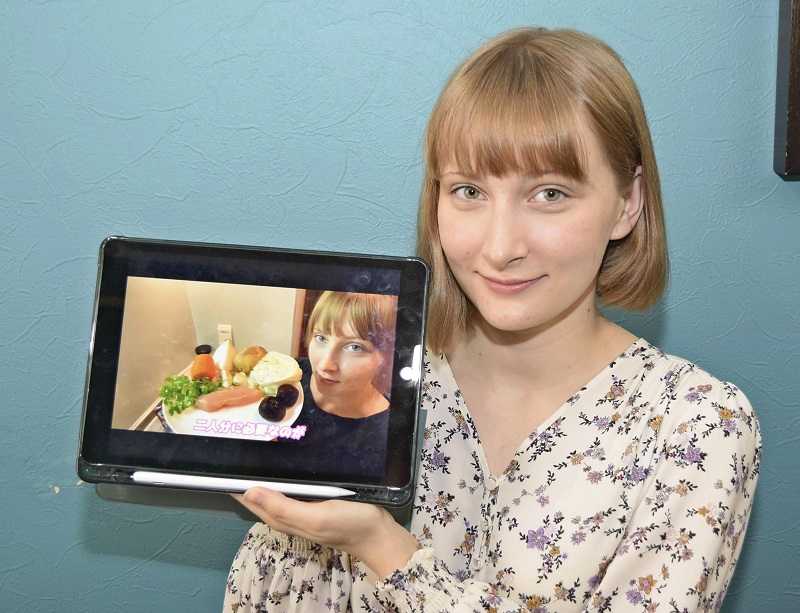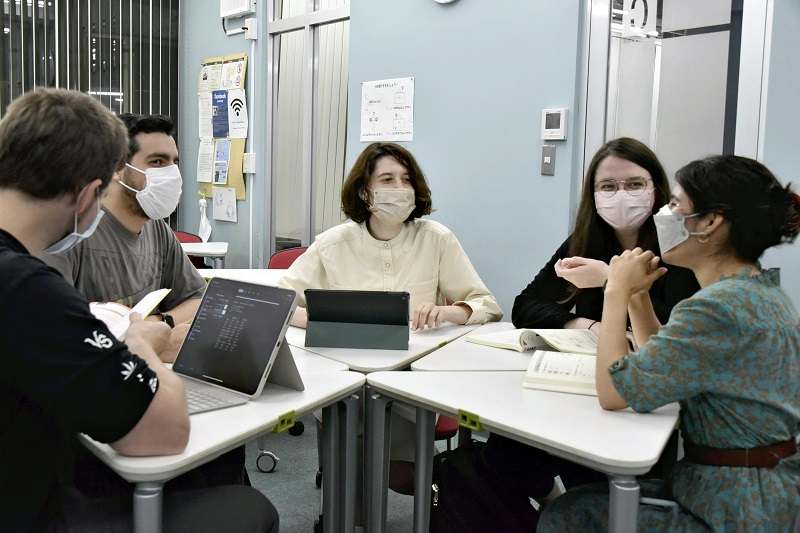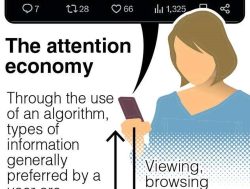Foreign students return / Ukrainian students grateful for Japan’s support

Valeriia Savenko shows a video she posted on YouTube in Shinjuku Ward, Tokyo, on July 28.
The Yomiuri Shimbun
13:41 JST, August 16, 2022
The recent relaxation of entry restrictions for foreigners opened the door again for overseas students to study in Japan. The Yomiuri Shimbun talked with students at Kai Japanese Language School in Shinjuku Ward, Tokyo. This is the second of a five-part series.
***
In a video posted on YouTube, Ukrainian student Valeriia Savenko introduces herself in Japanese and explains how to make beetroot soup known as borscht in her homeland.
Savenko, 21, fled to Japan after the Russian invasion of her country. She posts videos on YouTube and studies Japanese at the Kai Japanese Language School in Shinjuku Ward, Tokyo.
Born in Chernihiv in northern Ukraine, Savenko became interested in Japanese culture after watching Japanese anime when she was 15. She dated a Japanese student at her university in the eastern city of Kharkiv, and in January this year she began live-streaming herself playing “Ghost of Tsushima,” a game set in Japan during the Kamakura period (late 12th century to 1333).
In mid-February, with the Russian invasion looming, Savenko fled with her boyfriend to the nearby country of Georgia. As the invasion began and the Russian military took over the Chornobyl nuclear power plant, she decided to evacuate to Japan.
“I thought it would be dangerous unless we went far away,” she recalled.
Savenko came to Japan at the end of March, and began studying at the Kai school in early May. She had no one to rely on in Japan except her boyfriend, but school president Hiroko Yamamoto, 64, helped her find a place to live.
The school’s classes are free thanks to an aid organization’s support program for Ukrainian students. Savenko also receives supportive comments from Japanese viewers of her YouTube channel. She said she never thought she would receive such strong support in Japan.
Her hometown Chernihiv was surrounded by Russian troops at the beginning of the invasion. She has confirmed that her family is safe, but said she was overwhelmed by shock as her town and Kharkiv were destroyed by missile attacks and artillery shelling.
It was only after arriving in Japan that Savenko began posting videos about Ukrainian culture on YouTube.
Although her English-language skills are much stronger, she tries to present her videos in Japanese as much as possible. Savenko said she studies Japanese because she wants to live in the country and help Ukraine.
“I want to express my gratitude to the people of Japan and be a bridge between Ukraine and Japan,” Savenko said.
Fellow Kai student Mariia Novytska, 25, is also from Ukraine. A lover of animals, she is a qualified veterinarian. Russia’s invasion began while she was training at a veterinary hospital in Kyiv.
Novytska came to Japan at the end of May with the help of a support group for students from Ukraine. She was put in touch with the group by her 26-year-old sister, who works at a broadcasting station in Tokyo.
“I’d always wanted to come to Japan, but I never thought I’d do it this way,” Novytska said. Although it is nearly six months since the invasion started, she said it does not feel real, as if time is standing still.
Her Japanese still needs work, but Novytska is determined to learn to speak it as soon as possible and repay Japan for its support.
Novytska has four hours of classes every day, and spends at least another two hours doing homework. She has a notebook in which she has repeatedly practiced kanji she has learned.

Mariia Novytska, second from right, talks with school friends on July 15.
Support program
The number of evacuees from Ukraine reached 1,701 as of Aug. 7. Some came to Japan through study-abroad assistance programs, with about 40 using the program offered by Pathways Japan, a general incorporated foundation in Chiyoda Ward, Tokyo.
People who meet certain eligibility requirements, such as experience studying the Japanese language, can receive support for travel expenses to Japan and for tuition fees at colleges and Japanese language schools that have a partnership with Pathways Japan.
Eighteen universities, including International Christian University and Sophia University, had joined the program as of Aug. 8. The partnership also includes 26 Japanese language schools, such as the Kai Japanese Language School.
Pathways Japan aims to accept about 70 students at universities and about 100 students at Japanese language schools.
Popular Articles
Popular articles in the past 24 hours
-

Diplomacy with Central Asia: Utilize Long-Established Relationshi...
-

Poll Finds High Approval Rating for PM Takaichi’s Economic Measur...
-

Japan Actor Ryoko Hirosue Given Summary Indictment over Car Accid...
-

Japanese Actors Haru, Mahiro Takasugi Announce Marriage
-

Japan Shares Rise as Bond Yields Retreat; Tech Jitters Weigh on N...
-

9 Japanese Police Officers Suspected of Online Casino Gambling
-

Hepburn Romaji Deemed Standard for Japanese Words, Names; Change ...
-

Hakone Ekiden Banners Hung at Tokyo's JR Shinagawa Station Ahead ...
Popular articles in the past week
-

Israeli Tourists Refused Accommodation at Hotel in Japan’s Nagano...
-

U.S. Senate Resolution Backs Japan, Condemns China's Pressure
-

Sharp Decline in Number of Chinese Tourists But Overall Number of...
-

Japan Set to Participate in EU's R&D Framework, Aims to Boost Coo...
-

China Attacks Japan at U.N. Security Council Meetings; Representa...
-

Japan Backs Public-Private Cooperation on Economic Security; Nati...
-

As Chinese Tourists Shun Japan, Hotels and Stores Suffer
-

Bus Bound for Hokkaido's New Chitose Airport Catches Fire Wednesd...
Popular articles in the past month
-

Tokyo Economic Security Forum to Hold Inaugural Meeting Amid Tens...
-

Keidanren Chairman Yoshinobu Tsutsui Visits Kashiwazaki-Kariwa Nu...
-

Imports of Rare Earths from China Facing Delays, May Be Caused by...
-

University of Tokyo Professor Discusses Japanese Economic Securit...
-

Japan Pulls out of Vietnam Nuclear Project, Complicating Hanoi's ...
-

Govt Aims to Expand NISA Program Lineup, Abolish Age Restriction
-

Blanket Eel Trade Restrictions Rejected
-

Key Japan Labor Group to Seek Pay Scale Hike
"Society" POPULAR ARTICLE
-

M4.9 Earthquake Hits Tokyo, Neighboring Prefectures
-

Israeli Tourists Refused Accommodation at Hotel in Japan’s Nagano Pref., Prompting Protest by Israeli Embassy and Probe by Prefecture
-

M7.5 Earthquake Hits Northern Japan; Tsunami Waves Observed in Hokkaido, Aomori and Iwate Prefectures
-

Tsukiji Market Urges Tourists to Avoid Visiting in Year-End
-

High School in Kyoto Says Students Shoplifted during Recent School Trip to Bali, Indonesia
JN ACCESS RANKING
-

Tokyo Economic Security Forum to Hold Inaugural Meeting Amid Tense Global Environment
-

Keidanren Chairman Yoshinobu Tsutsui Visits Kashiwazaki-Kariwa Nuclear Power Plant; Inspects New Emergency Safety System
-

Imports of Rare Earths from China Facing Delays, May Be Caused by Deterioration of Japan-China Relations
-

University of Tokyo Professor Discusses Japanese Economic Security in Interview Ahead of Forum
-

Japan Pulls out of Vietnam Nuclear Project, Complicating Hanoi’s Power Plans








